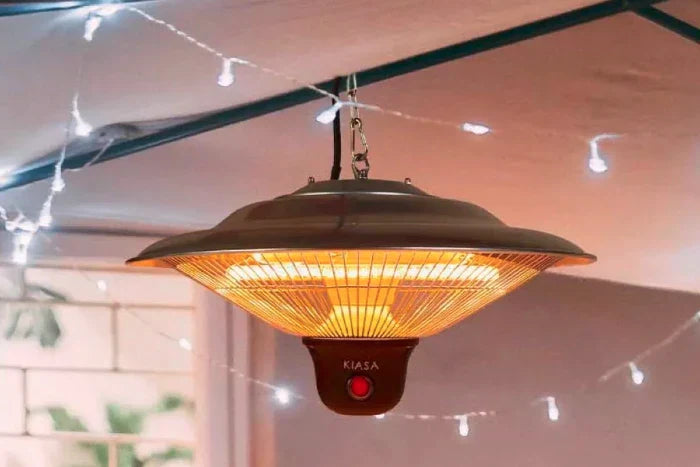Summer has come early and here’s hoping it lingers longer. With a surge in working from home post Covid, there is an ever-increasing trend to spend more time outside and relax, eat and drink al fresco. With a renewed focus and increased home investment in patio comfort and cosy kit, outdoor heating and garden heaters in general have become an essential investment. Two of the most common types, electric and gas patio heaters, offer distinct benefits and drawbacks. However, as of 2025, a clear winner has emerged: infrared electric heaters, and for good reason.
Electric Infra-Red Heaters Use Energy More Smartly and Efficiently
Gas patio heaters, particularly those using propane or natural gas, work by heating the air around them. It’s a method that is inherently inefficient outdoors, where open space, and especially wind, can quickly dissipate the warmth. In contrast, Infra-Red patio and garden heaters use radiant heat to directly warm people and objects rather than the air. This direct approach means less wasted energy and more effective warmth exactly when and where it's needed.
When It Comes to Cost and Maintenance: Infra-Red Wins Long-Term
While gas patio heaters, especially smaller propane units, may seem cheaper up front their running costs add up quickly. A typical 13kg propane bottle can cost over £40 and last around 10-15 hours. Electric Infra-Red heaters are much cheaper to run. With no fuel to purchase, no tanks to replace, and far less maintenance required (no burners to clean, no pilot lights to check), they offer a low-hassle, cost-effective heating solution over time. Most are plug-and-play, requiring just a standard outlet and a 2Kw heater costs as little as 60p per hour.
Safety and Environmental Impact: Infra-Red Is Clean and Green
Gas heaters carry inherent health and safety risks. Combustion produces carbon monoxide, which means gas heaters should never be used in enclosed or semi-enclosed spaces. There's also the fire hazard of open flames or hot surfaces. In environmental terms they contribute to greenhouse gas emissions and local air pollution.
Infra-Red heaters eliminate many of these concerns. Wall mounted patio heaters are emission-free during use and do not rely on combustion, making them safer for both indoor and outdoor use. Many models are now made with recyclable components, further improving their environmental footprint. With the ongoing push toward electrification and sustainable living, electric outdoor heaters align better with climate goals and urban clean-air initiatives.
Infra-Red Outdoor Heaters Are Sleek, Unobtrusive and Quiet
Modern patio heater design transcends far beyond the clunky mushroom-style gas models of the past. Electric Infra-Red heaters now come in sleek designs, and stylish overhead units, that blend into patio ceilings or pergolas. A major bonus is that wall mounted outdoor heaters or outdoor gazebo heaters are silent when running, unlike gas heaters which often emit a low roar or hiss and pop when in use.
Taken together these aspects of Infra-Red electric heaters make them ideal space heaters for residential decks and even commercial patios, restaurants, and rooftop lounges where ambiance matters as much as heat.
Smart Integration Means More Control
One of the standout features of today’s Infra-Red heaters is their smart capability. Many models now support app control, timers, motion sensors, and integration with smart home systems like Alexa, Google Home, or Apple HomeKit. Adjusting heat output, scheduling use, or managing zones across large areas has never been easier.
Gas heaters, by contrast, offer limited control and are largely manual. Temperature regulation is basic, and integration with smart ecosystems is almost non-existent.
Infrared Heaters Are the Future
In short, Infra-Red heating panels emit electromagnetic waves that travel unimpeded through the air until they strike a solid surface. This makes them highly efficient in open or semi-open outdoor spaces, especially on windy evenings when gas heaters struggle to maintain comfort levels. All things considered electric infrared heaters are the clear choice. Their superior efficiency, lower operating costs, safety, environmental friendliness, and integration with modern technology make them the smarter, more sustainable heating solution for outdoor spaces.



